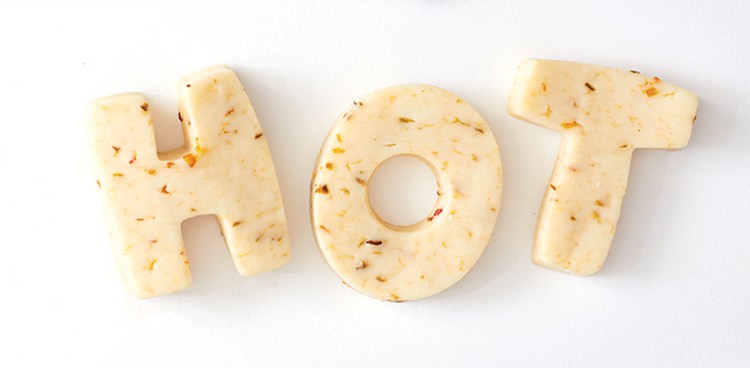
Some Like It Hot is featured in our Summer 2017 issue. Click here to read our spicy cheese tasting notes.
To understand the power of peppers, bite into Dragon’s Breath Cheddar from Henning’s Wisconsin Cheese. The moment the curds enter your mouth, a compound called capsaicin—present in added habanero chiles—awakens receptors on your tongue. Called polymodal nociceptors, their role is to alert the brain of intense disturbances, such as extreme temperature or hazardous acidity. Soon your central nervous system alarms are firing, signaling imminent danger: Cue burning, blood vessel dilation, sweating, and flushing. If it feels as if your mouth is on fire, that’s because your brain believes your mouth is literally on fire.
This reaction is generally considered a pain sensation rather than a taste. And it’s no joke: Kay Schmitz from Henning’s explains that the Kiel, Wis.–based company once made an even spicier cheese called Scorchin’ Scorpion with scorpion peppers, which were simply too hot. “We had to stop making it,” she says. “[Working with the peppers] was dangerous for our employees—even with gas masks on!”
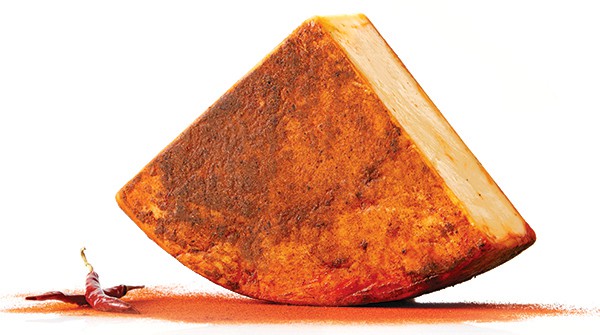
Beehive Cheese Company’s Big John’s Cajun
A Painful Preference
This prompts a logical question: Why would someone suffer voluntarily through such pain? It’s a dilemma that Paul Ronzin, a psychologist at the University of Pennsylvania, once pondered. Chile eating, he surmised in a 1980 paper, is a thrill-seeking activity—comparable to “riding on rollercoasters” and “taking very hot baths.” Satisfaction, he wrote, derives from tricking the brain into perceiving a threat—and then enjoying the wave of relief that comes with the realization of safety. Rozin coined a term to describe this feeling: benign masochism.
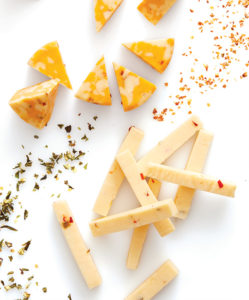
Kindred Creamery’s Ghost Pepper Colby Jack (top) and Rumiano Cheese Company’s Organic Pepper Jack
It appears that benign masochism is on the rise in America. By 2019, the hot sauce market will be growing 15 times faster than the overall sauces market in North America, according to Euromonitor International. And it’s not just Tabasco; in dozens of hot sauce-specific shops across the US, where bottles with dread-inducing names such as “Lethal Ingestion,” “Satan’s Blood,” and “Unbearable” line the shelves, it’s clear that makers are vying for the title of hottest-of-the-hot.
Ingredients are also getting hotter. In 2013, the Guinness World Records crowned Carolina Reaper—a pepper with a Scoville rating of 1,569,300 units—as the world’s hottest. (The rating measures capsaicin concentration—jalapeños usually rate below 10,000 on the same scale.) According to Ed Currie, the South Carolina-based plant breeder who developed it, the pepper tastes sweet initially. Then “the heat hits you, and it’s like you have a mouthful of lava,” he says. “The burn is tremendous.”
As condiments have become more piquant, so has cheese. It’s unclear whose idea it was to marry jalapeño peppers with Monterey Jack, but the ingredient was one of many added flavorings that California makers experimented with in the 1980s. Within a few decades pepper Jack, a springy, mild cheese with a slight kick, burst onto the mainstream. In 2012, USA Today reported it was one of the country’s fastest-growing cheese styles, ubiquitous as a burger topper in fast-food restaurants. (Today it even flavors Cheez-Its.)
Looking back on US cheese market data, Suzanne Fanning, vice president of national product communications at the Wisconsin Milk Marketing Board (WMMB), notes that jalapeño-flecked cheeses made up one-fifth of the ever-expanding flavored cheese category’s sales in 2016. But that year was also the first in which wheels spiked with the beloved pepper experienced a slight decline in sales, while those flavored with habanero—a chile that can be up to 35 times hotter than the hottest jalapeño—saw a marked increase. “Interest in less familiar hot peppers is on the rise,” Fanning says.
Producers haven’t stopped at habanero. Cheddar infused with Indian Bhut jolokia, a.k.a. ghost pepper (once considered the hottest in the world), accounted for 30 percent of entries into the US Championship Cheese Contest’s “high heat” flavor category in 2017. Wisconsin-based Cesar’s Cheese makes Angel de la Muerte (“Angel of Death”) cheddar with Currie’s Carolina Reapers. Looking at the growth in spicy cheese over time, Currie acknowledges an endless pursuit of heat. “I’m going to have to release a new pepper sometime soon,” he muses.
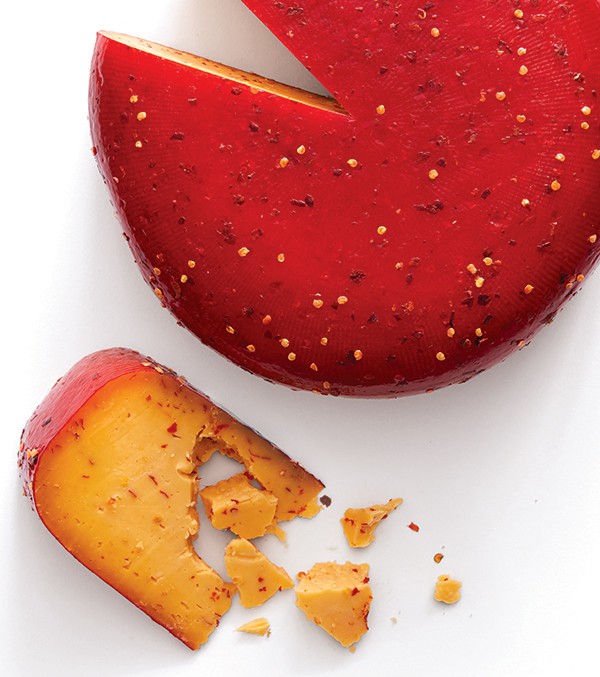
Roth Cheese’s Sriracha Gouda
Mirroring the Melting Pot
In the early 1980s, Rozin, the psychologist puzzled by the pursuit of heat, embarked on an experiment: He baked colored crackers with differing concentrations of chile oil and fed them to chimpanzees. The chimps quickly learned that the yellow crackers were spicier than the green ones, and avoided them. As trials continued, however, subjects started reaching for the yellow crackers more often. Each time scientists upped the spice on the yellow crisps, the chimps would initially return to green. Over time, though, they’d shift to yellow again. Rozin’s conclusion? The chimps built up an acquired tolerance—and preference—for spice.
Paul Bosland, co-founder and director of the Chile Pepper Institute at New Mexico State University, sees a similar pattern with humans in his home state, where chile flakes are a staple at the dinner table. “When people move to New Mexico, at first they might look for mild chiles,” he says. “But within a year they’ll be up to medium spice.”
Is it possible that this tolerance building is happening across our entire society? Bosland points out that many of North America’s early settlers hailed from Northern Europe, where hot peppers are rare.
“My grandparents, my parents, they wouldn’t eat spicy food,” he says. “They liked sauerkraut, potatoes. You know—bland.” Newer generations born and raised in regions like the Southwest, where European culinary traditions mingle with native crops and cuisines, have grown to love heat. “Young people like spicy, hot food,” Bosland says. “They’ve embraced it.”
It’s not just native chiles they’re falling for. According to data published in 2016 by the United States Department of Agriculture, chile pepper production in California and New Mexico grew by about 85 percent between 1980 and 2014. During the same period, imports of dried hot peppers increased by over 1000 percent. Scott Hall, owner of spice-importing company Occidental International Foods since 1999, has witnessed soaring demand for what he calls “exotic” peppers.
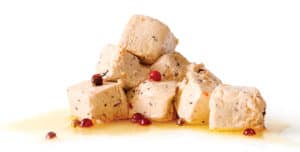
Chevoo’s Aleppo-Urfa Chili and Lemon
“In the early years I sold mainly paprika, cayenne, black pepper,” he says. “Now we stock more than 160 items, including hard-to-find spices like ghost chiles [and] habaneros.”
Hall chalks it up to America’s increasingly multicultural social fabric. Currie agrees, citing an influx of immigrants from the Caribbean, Africa, and Southeast Asia in the last few decades.
“The market has evolved,” Hall says. “Through the diversification of America we’ve been exposed to extremely spicy foods.” Growing up in this pluralized society, dining out frequently, and traveling more than their parents did have exposed younger generations to spice, encouraging tolerance, appreciation, and curiosity.
All of that is expressed in cheese. “Millennials seek out cheeses that reflect their globalized palate,” says the WMMB’s Fanning. Gina Mode, who teaches courses on flavored cheese at the Wisconsin Center for Dairy Research, concurs, noting a rise in cheeses seasoned with Hatch and chipotle peppers, plus sriracha and kimchi. “There are a lot of particularly ethnic flavors,” she says. “People have gotten really creative with peppers.”
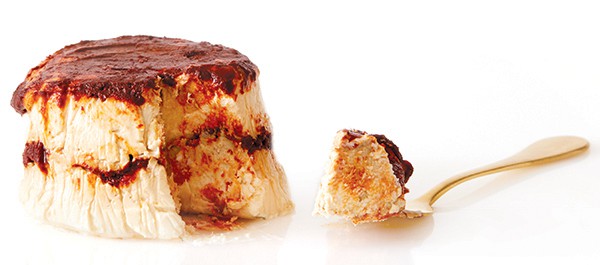
Mozzarella Company’s Ancho Chile Mascarpone Torta
Focusing on Flavor
When Chevoo co-founders Gerard and Susan Tuck first dreamed up infusions for their olive oil-marinated fresh chèvre, they didn’t choose a blend of Urfa and Aleppo chiles for the sake of exoticism—and especially not to “blast people,” Gerard says. It was more about crafting flavor profile: heat that builds slowly, tamed by lemon and creamy cheese. The combo highlights the mild chiles’ innate qualities: Aleppo’s fruitiness, Urfa’s smokiness.
Co-owner Pat Ford of Beehive Cheese in Uintah, Utah, also believes that the virtue of spice is in its complexity. “It’s not just about slappin’ something really hot on the outside of the cheese,” he says, referencing Beehive’s spice-rubbed wheel Big John’s Cajun. “You’re not going to get slapped upside the head with a two-by-four [of] heat. It’s subtle, complex.”
Chile expert Bosland has always taken issue with classifying heat as pain rather than taste. He points to many Asian cuisines, where heat—along with bitter, sweet, and sour flavors—is considered necessary for balancing dishes. “Chile heat is like salt: You can always put too much,” he says. “But just as every chef will tell you that a little salt enhances a dish, I’d argue that a little bit of chile also enhances a dish.”
In Vermont, cheesemakers at Plymouth Artisan Cheese blend an Indonesian-style pepper relish called sambal into fresh curds before molding. Marketing manager Sarit Werner notes that while the relish itself is super-spicy, it yields more of an umami taste in the cheese. It’s also tempered by a dash of Vermont maple syrup, mixed into the condiment before it hits the vat.
That combination—which she calls “Vermont Sambal”—reflects another tendency among American cheesemakers: to imbue spicy ingredients with new dimension and meaning. “The blend we came up with is really working for Vermont,” Werner says. “Even though a lot of people haven’t heard of sambal, they’re intrigued. They’re fascinated.”
As 19th-century epicure Jean Anthelme Brillat-Savarin famously proclaimed, “Tell me what you eat, and I’ll tell you who you are.” Imagine if he was still around to taste cheeses like this one, laced with unlikely bedfellows of sweet Green Mountain and spicy Indonesian flavors. No doubt he’d recognize our multi-culturalism, thrill-seeking nature, and eternal quest to spice things up.
Tasting Notes
BIG JOHN’S CAJUN
Beehive Cheese Company
Uintah, Utah
Pasteurized cow’s milk
Hot stuff: Cayenne pepper and Cajun spice blend
Dive into this wheel’s Cajun spiciness by snagging a piece that includes the rubbed rind. Its bold, addictive flavor is meaty, reminding us of barbecue, chili, and soy sauce.
ANCHO CHILE MASCARPONE TORTA
Mozzarella Company
Dallas
Pasteurized cow’s milk
Hot stuff: Ancho chiles
Layers of smoky ancho contrast beautifully with bone-white mascarpone in this appetizer-ready round. Stay tuned for slight back-of-the-palate warmth and hints of sundried tomatoes.
GHOST PEPPER COLBY JACK
Kindred Creamery
Muscoda, Wis.
Pasteurized cow’s milk
Hot stuff: Habanero and ghost peppers
A sneaky one, with initial notes of toasted pepper and cumin—until several seconds later, when flames engulf your entire mouth.
DRAGON’S BREATH CHEDDAR
Henning’s Wisconsin Cheese
Kiel, Wis.
Pasteurized cow’s milk
Hot stuff: Habanero peppers
The name fits: Laced with visible, slightly crunchy pepper flakes, this cheddar tastes tame and tangy before vicious heat crashes in. A burning sensation targets the back of the tongue.
ALEPPO-URFA CHILI AND LEMON
Chevoo
Sonoma, Calif.
Pasteurized goat’s milk
Hot stuff: Aleppo and Urfa chiles
An initial hit of lemon complements Aleppo chile’s fruity notes. Urfa chile’s subtle heat and smokiness stick around after the uber-soft chèvre melts in the mouth.
GHOST PEPPER JACK
Glanbia Nutritionals
Twin Falls, Idaho
Pasteurized cow’s milk
Hot stuff: Ghost peppers
A balance of cool cream and searing spice, this brick smells of brine and peppers, with hints of dill pickle and olives.
ORGANIC PEPPER JACK
Rumiano Cheese Company
Willows, Calif.
Pasteurized cow’s milk
Hot stuff: Jalapeño peppers
A classic exemplar of America’s first hot-pepper cheese style: milky, smooth, and gentle. Get in our quesadilla!
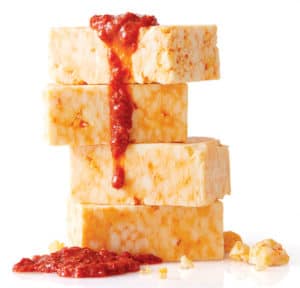
Plymouth Artisan Cheese’s Sambal
SAMBAL
Plymouth Artisan Cheese
Plymouth, Vt.
Raw cow’s milk
Hot stuff: Sambal relish
Aromas of garlic, mango, and curry waft from this pretty marbled cheese. There are notes of roasted tomato and sour cream, finishing with a hint of sweetness from the maple syrup.
HOT STUFF BUFFALO WING CHEDDAR
Yancey’s Fancy
Corfu, N.Y.
Pasteurized cow’s milk
Hot stuff: Jalapeño, habanero, and cayenne peppers; hot sauce
Somehow this waxed wedge manages to be just as flavorful as it is scorching. All buffalo wing sauce on the nose, the mouth-coating paste offers creaminess and tang that stands up to the fire.
SRIRACHA GOUDA
Roth Cheese
Monroe, Wis.
Pasteurized cow’s milk
Hot stuff: Sriracha; red pepper; chile extract
Mild and buttery upfront with hints of yogurt and sweet chile sauce, this red-flecked gouda incites a slight heat that builds in the throat and lingers pleasantly.




